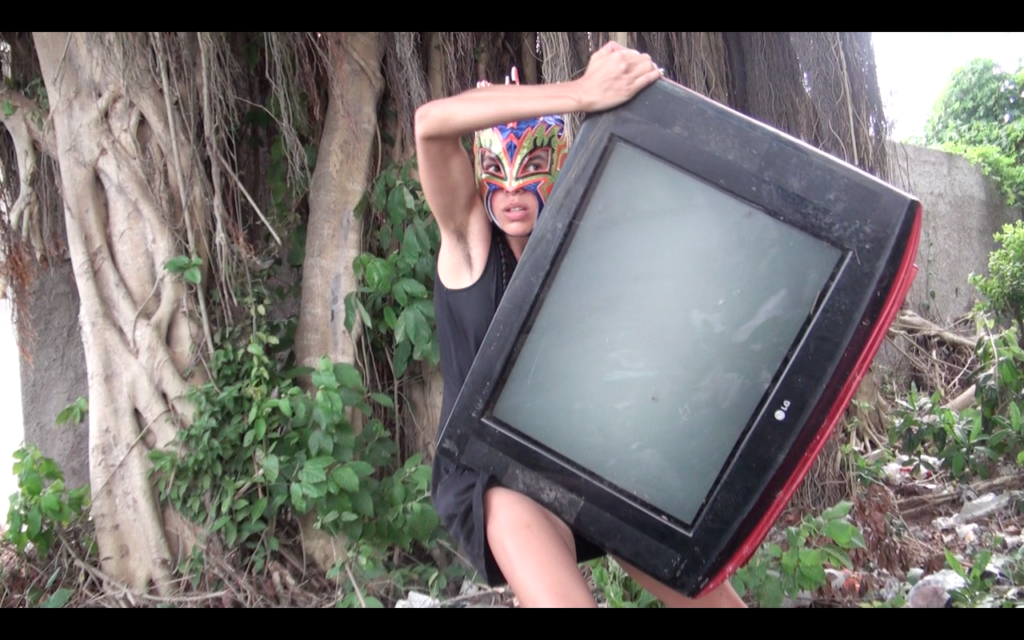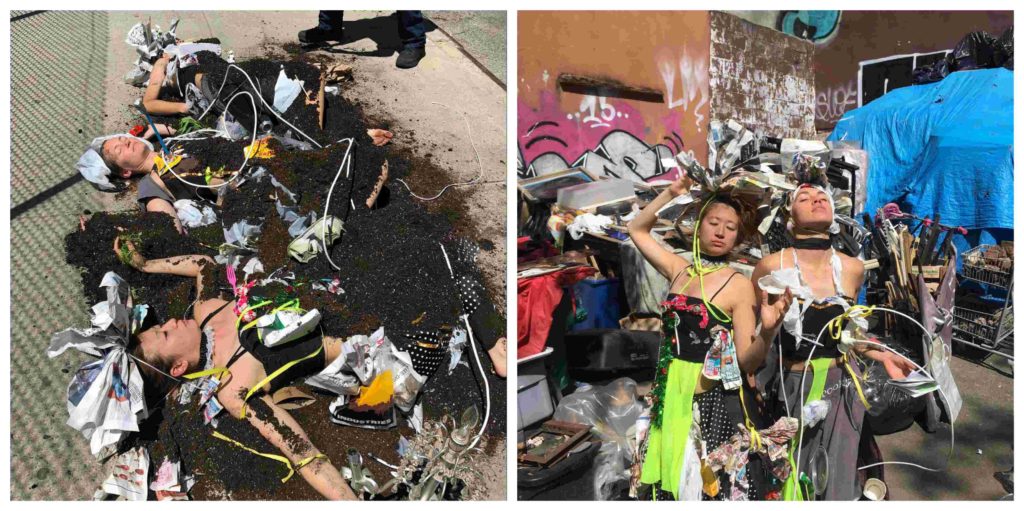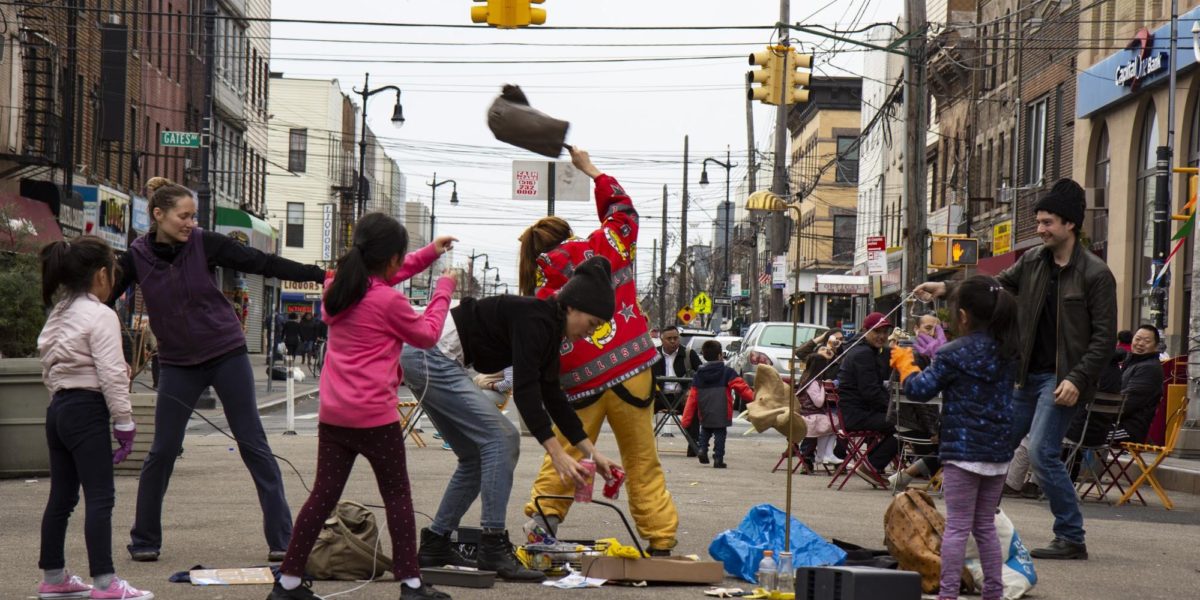Eco Hero Maira Duarte Dancer is a choreographer, artist, curator and organizer. She uses performance art to raise our awareness of trash in our lives. This is her story.
History
Dance to the People, a collective of dancers and other performers and artists, began exploring outdoor movement research when Joanna Stone proposed an environmental dance project titled Evolution is not Anthropocentric in the summer of 2015. The collective held sessions in outdoor public spaces where performers and participants experimented with movement techniques and structures of authentic movement, contact improvisation and meditation in relation to the natural environment around them.
Since then, Joanna Stone, and I, Maira Duarte, have collaborated in this research, defining our practice more as a form of resistance to the unrestrained economic greed that results in the objectification, disrespect, devaluation, and destruction of plant life and animal life in the name of centering human agendas-typically, white, western desires.
From 2016 to 2018, we held various outings in parks and public beaches. During beach outings at Fort Tilden beach in the Rockaways, we collected trash, and recorded data about the trash we found, which was sent to the Ocean Conservancy. The most common items in the beach are small pieces of plastic: tampon applicators, cigarette mouthpieces, straws, forks, etc. The tragic images of the Great Pacific garbage patch represent a fraction of our problem. Small pieces of plastic cause the most damage to ocean life as they are ingested and accumulated up the food chain.

We also offered a workshop on Environmental Dance in 2018 as part of our contribution to Foro Performatica in Mexico.

Disrupt Production and Consumption
A goal of Dance to the People is to disrupt ways of producing and consuming art that are tightly linked to capitalist behavior. We believe that capitalism acts as a homogenizing force that strangles other forms of living. In December 2018, we organized a forum called Where Do I Get My Tortillas, where artists came together to discuss labeling and tokenism in the process of creating, funding and presenting art. Others Unite was a sequel forum in March 2019 where the discussion broadened the term “otherness” into what is happening to vulnerable populations (black and brown communities, the LGBTQ community, and immigrants mainly from Mexico, Guatemala, Honduras, and other countries in the Americas) in relationship to what is happening to the environment. One of the projects presented at the forum was the Papalot-Muyus dance film that came out of a collaboration with Semillas Collective and Mayday Space, featuring children of immigrants living in New York, all descendants of indigenous peoples in the Americas, mainly from Mexico and Ecuador. The film is a protest against the separation of families at the border, and against corrosive speech towards immigrants which has hardened in the current administration. The children performed warrior indigenous dances as well as a movement score about the relationship of immigration with nature, picturing the children as seeds and as butterflies.
Street Performances
Another approach was street performances. For example, in December 2018, I collaborated with photographer Daniel Alveal Aravena in Tulum, Mexico, with a street performance interacting with trash in a neighborhood of La Invasión (the invasion), which owes its name to the fact that its inhabitants (mostly recent migrants from Chiapas, who are fleeing conflict there) take on unused land and build their houses with found materials. The irony is that Tulum is actually being invaded by hordes of foreign tourists and developers who displace poor communities and, with the rampant construction of hotels and restaurants, are dedicated to serve rich people, jeopardize the capacity of the coast to resist storms and damages the integrity of Sian Ka’an, one of the last natural reserves of the area.

Last May, we performed at Earth Celebrations, a parade of climate solutions from the community gardens of the Lower East Side to East River Park. Our performance began with Miu Soda, Joanna Stone and me lying on the sidewalk covered with dirt. We were dressed in our trash costumes, designed by our collaborator Nicole Touzien. She created dresses with found materials, to which we attached as many pieces of common trash we could find. We slowly struggled to rise to standing positions; our movements represented the resilience of nature against human impact, of coping with the reality that trash is and will be a part of who we are no matter what road we take.

Afterwards, Miu and I continued to parade and dance in our costumes through the streets, going inside stores and sitting in parks. We attracted the attention of many onlookers, who would take pictures, ask questions and share their stories. One girl touched a chopstick that was hanging from my dress. She said, “I want one!” It was incredible that a piece of trash, just because it’s worn in a fashionable way, can acquire such value. A reporter asked where we found the trash, as if there were a special place to find trash! Every minute, trash is being produced and disposed of. It’s everywhere and anywhere!
Mindful Trash Movement
Starting 2019, we decided to focus the research on the direct product of capitalism: unsustainable amounts of trash and the difficulty to stop producing it. Because this project is a continuation of the practices we had in previous outings, which include meditation in nature and parks, we’ve titled the whole project: Mindful Trash Movement.
We organized four Trash Outings in Bushwick, Brooklyn. Lasting three hours, each Trash Outing had three parts.
The first part was held in María Hernandez Park and was devoted to “unplugging from the machine” and directing our senses towards nature. During a walking meditation with our eyes closed, we are reminded to be in the present moment, to connect to sound, to the feeling of our feet being supported by the earth. We are reminded to feel gratitude towards the earth. Next, we moved to movement meditation, again with eyes closed. We are invited to respond to inner and outer stimuli. As we feel the grass, we acknowledge that the grass feels me too. We then transition to movement with eyes open if we wish. We let sight inform our experience. We borrow the idea of “witnessing movement” from the practice of Authentic Movement, but in this case we are invited to witness something in nature, such as a tree or a bird, or a stone. And then we allow that tree or rock or bird to witness us.
In the second part, we took to the street, picking up trash that we divide into several categories. Some are “trash trash”: dirty, wet, unsalvageable. Some are recyclable, which are placed in appropriate bins or given to people to take to redemption centers for bottles and cans. We also perform with trash that we collect, including an old American flag, an iron, a painting of trash, giant stuffed animals, a tree, a chandelier, and even a wall-mountable elephant’s head. One person’s trash is another person’s treasure, and upcycling is just as important as reducing what we consume.
The third part took place outside Bushwick’s Myrtle/Wyckoff subway stop, with a live improvised performance by all participants with their found trash. Each person playfully explored the materials, significance, and journey of the trash they found, and perhaps, their own part in that journey. Onlookers often joined in the dance, asking questions and sharing comments on their relationships with trash.

Our lives teem with trash. This is our “normal” and as a result, the trash is not visible to us. Upcycling and “trash fashion” are tools that open our senses to the trash. Trash Outings uses art and aesthetic experiences to make the trash visible to us.
We invite you to join us tomorrow for our Trash Outing #5 Dumpster Edition (Friday, June 21st, 1-4 PM in McGolrick Park) and Mindful Beach Trash Outing #6 this weekend (Sunday June 23rd, 4:30pm at Fort Tilden Beach). This is our call to action! In the words of philosopher Byung-Chul Han, “The course our future takes will depend on whether we prove able, beyond the world of production, to make use of the useless.”
By Maira Duarte



